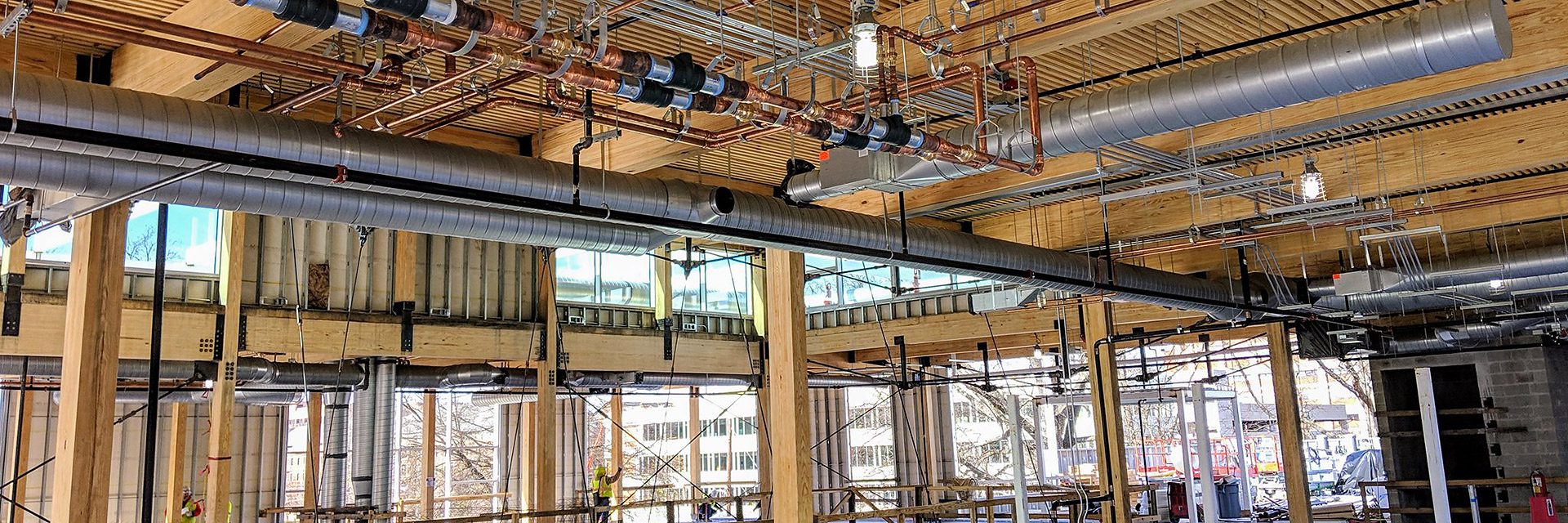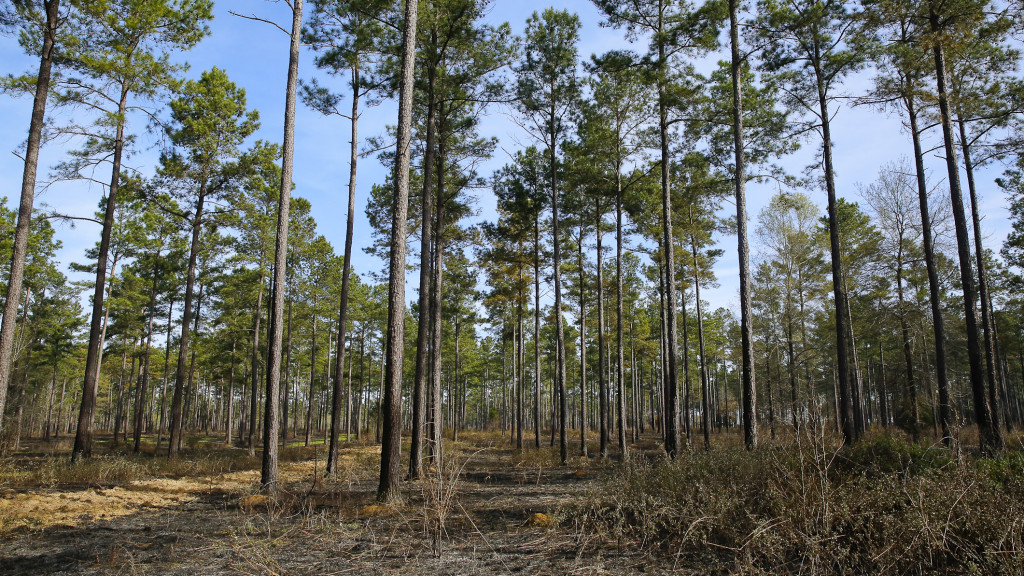Russell Gentry Chairs State Sustainable Building Material Committee

April 5, 2022 — Atlanta, GA
Wes McRae | April 5, 2022
Russell Gentry, director of the Digital Building Lab, has been appointed chair of the newly created Sustainable Building Material Technical Advisory Committee. The committee will work to reduce greenhouse gas emissions by creating a method for calculating the net carbon held in existing wooden structures.
Trees naturally capture carbon dioxide, the most significant greenhouse gas, and Georgia already has a registry for carbon held by living trees. But trees used for construction also hold about half their weight in carbon, Gentry said.
“So if you have 100,000 pounds of wood in your building, then there’s 50,000 pounds of carbon that’s sequestered in that wood [for the life of the building].”
Gentry will lead the committee’s approach as they create a carbon-tracking process for trees used in construction. Wood building materials will then be part of the state’s carbon registry, which will allow carbon credits to be bought and sold.
The committee also relies on Valerie Thomas, the Anderson-Interface Chair of Natural Systems in the H. Milton School of Industrial and Systems Engineering, to determine net carbon benefit of sustainable materials versus conventional construction materials.
Thomas brings expertise in life cycle assessment to the committee. She looks at the whole life of the building material, from manufacture to disposal, to develop an accurate idea of environmental impact.
“Some of the part I’m especially tasked with is, ‘How do you quantify this? How much is it?’,” Thomas said.
It’s not as simple as adding up the weight of lumber used and dividing by half. “We have transportation, sawmills, and treatment,” she said, “and we’re probably using fossil fuels to do it.”
The environmental cost of all those processes must be compared to the costs of processes associated with concrete and metal frame buildings.
To make sure the credit for captured carbon is meaningful, “We have to look at all that to make sure the comparison is quantitatively sensible.”
California and Canada's British Columbia have related carbon-tracking systems, which provide incentives for using their timber in construction.
“Georgia is the largest forestry state in terms of structural lumber production,” said Gentry, “but we don’t have a lot of mass timber being produced from Southern Pine, so that’s considered to be a competitive disadvantage for the southeastern United States.”
This amendment to the current carbon registry provides incentive to use Georgia timber in construction, rather than bringing it in from other states. It will also help builders prove their commitment to greener development, Gentry said.
“Mass timber ties the logging and forestry industry -- a core business of rural Georgia -- to Atlanta where we have this huge influx of people. Cities need to build lots of multifamily housing, but in a thoughtful and environmentally conscious way,” said Gentry.
“This project speaks so well to both Georgias, and I think that’s part of the challenge we see in many things right now, is knitting that together. If there’s a win on both sides, it’s a good win.”
Building Taller and Cleaner with Mass Timber

At the Digital Building Lab, Georgia Tech researchers develop new ways of using mass timber in commercial construction.
“Mass timber is a process of cutting a tree up into lots of small pieces, essentially observing and removing the defects and then putting those boards back together to make huge pieces of wood,” said Gentry.
“This could be a panel of wood 10 feet by 40 feet by a foot and a half thick,” he said. “That's like a piece of plywood on steroids. That can become a floor system in a 20-story building.”
Mass timber is a relatively new technology: in 2021 Georgia building codes were updated to allow for timber buildings taller than 5 stories using the new mass timber technology. These changes allow for taller and more cost-competitive mass timber buildings.
Very few buildings in the state use mass timber technology. Two local examples are the Kendeda Building, on the Georgia Tech campus, and T3 West Midtown, a 7-story office building in Atlantic Station, near the Georgia Tech Campus.
Although the committee is not the first research group to look at carbon held in buildings, they will still have to develop new models to compare how much wood construction captures carbon as compared to traditional steel, Thomas said.
But, she said, the research is so new that “we can’t just look at what everybody else does and say, ‘that's what we're doing’.”
According to Thomas, the committee is “defining the regulations that will make it possible to have mass timber buildings that sequester carbon in the state of Georgia, and I expect that the procedure we use will be used by others also in the USA and in other countries. So we’re directly applying our expertise to support the state of Georgia.”
One implicit consequence of the amended carbon registry is that it “encourages building these innovative types of buildings in Georgia,” said Thomas.
“I grow my tree. I cut it down. I make a building with it so it's just sitting over there for hopefully a very long time. And then I grow another tree. So I'm taking carbon out of the atmosphere and putting it into buildings on a continuing basis.”
For carbon sequestration to have an impact on the environment, “we're not talking one or two buildings in Atlanta. It has to be really large scale,” said Thomas.
“If we’re going to get the climate stabilized at 1.5 degrees centigrade increase, we’ve got to have some kind of technology for taking carbon out of the atmosphere.”
Growing a New Industry at Georgia Tech

And cultivating a new type of construction is no small endeavor, Gentry said.
“The mass timber problem is one of integration. It’s not like there’s a specific problem with adhesive bond lines or the density of wood. The real problem is the entire ecosystem that it’s going to take to make a mass timber industry in Georgia.”
Mass timber components require development of sophisticated manufacturing techniques.
“There’s tremendous capital expense for the presses that make these materials, and automation and CNC equipment that cuts these things into the kind of interlocking shapes that come to the job site and make these buildings so easy to erect,” Gentry said.
“In the Digital Fabrication Lab (DFL) we have much of that equipment. Our students are learning to run that equipment, and so this semester our students are exploring the design and economic potential of mass timber, looking at not only design of buildings, but also the technical aspects of prefabricating the components and bringing them to the site.”
The fact that Gentry and his students can prototype and deliver these building components right from the DFL amplifies the impact, he said. “I think one of the huge strengths of Georgia Tech is its ability to deliver not just knowledge, but instances of that knowledge applied.”
Gentry speaks from experience: he’s an alumnus of the Institute as well as a decades-long faculty member of the Schools of Architecture and Civil and Environmental Engineering. So, too is another member of the Sustainable Building Material Technical Advisory Committee, Devon Dartnell (EE '84) Director of Market Analysis and Research at the Georgia Forestry Commission, and a Georgia timberland owner. Dartnell manages the work of the committee for the Forestry Commission.
The legislation identifies the specific viewpoints and expertise required to craft the new sustainable building carbon registry. Members include Edie Sonnie Hall, a life cycle analysis consultant from Washington State; Brian Campa, Principal at Cooper Carry; Jacek Siry, Professor of Forest Economics at the University of Georgia; Troy Harris, Managing Director of Timberland at Jamestown; Ted Miltiades, Director of Construction Codes and Industrialized Buildings at Georgia Department of Community Affairs; and Bill Howard, General Manager of Claude Howard Lumber Company.